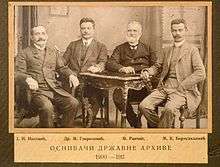Archive of Serbia
| Arhiv Srbije / Архив Србије | |
|
| |
| Established | 1900 |
|---|---|
| Location | Palilula, Belgrade, Serbia |
| Type | National Archive |
| Director | dr Miroslav Perišić |
| Website | www.archives.org.rs |
The Archive of Serbia (Serbian: Архив Србије / Arhiv Srbije), is the national archive of Serbia, located in Belgrade. It houses and protects documents and other archival materials produced by state bodies and organizations of Serbia before 1918 (before Serbia became part of the Kingdom of Yugoslavia) and documents produced during and after World War II (when Serbia was federal subject within Communist Yugoslavia and Serbia and Montenegro).[1] Documents dating from the period when Serbia was part of the Kingdom of Yugoslavia and documents produced by the state bodies and organizations of Yugoslavia from 1918 to 2006 are kept in the Archives of Yugoslavia, also in Belgrade.[2]
History
The first proposal to establish a national archive came in 1847, but the Law on National Archives was only adopted on 14 December [O.S. 2 December] 1898.[3] The Archive began operation in 1900. Its first official name was National Archive of the Kingdom of Serbia. The name was changed several times. Between 1918 and 1945 it was called National Archive (during this time it was National Archive of the Kingdom of Yugoslavia). Between 1945 and 1948 the name was National Archive of the Federal People's Republic of Yugoslavia. Between 1948 and 1969 it was National Archive of the People's Republic of Serbia (the separate Archives of Yugoslavia were established in 1950). In 1969, the Archive was given its current name, the Archive of Serbia.[3]

The founding members of the National Archives were: J. N. Ivković, Dr. M. Gavrilović, M. Rančić and M. K. Borisavljević.[3]
During World War I, some archive material was moved to Niš and Kragujevac, but some remained in Belgrade. During the retreat of the Serbian Army, some of the archives were destroyed, some lost, but much was preserved in a train car in the Kruševac train station.[3] After the war, the Archive became the National Archive of the newly formed Kingdom of Serbs, Croats and Slovenes (Yugoslavia). The current building of the Archive was dedicated in 1928.
During the World War II, some of the archive material was confiscated by the Nazi German authorities. German Army occupied the building in two periods, so much of the archive was moved to the Faculty of Technology and the Belgrade University Library and the most valuable items were placed in the National Bank's safes. After the war, the Archive became the National Archive of the newly formed Federal People's Republic of Yugoslavia, until 1 January 1948 when the separate Archives of Yugoslavia were formed.[3]
Archive today
Serbia today operates an extensive network of archives that cover the whole of the country. Although the National Archive in Belgrade was heavily damaged during World War II, the archives still hold a large amount of information that dates back to early medieval times.
Archives and collections
Within its 972 archives and 51 collections, the Archives of Serbia houses 10 kilometers of historical records.[4] When taking the time of origin into account, the archival materials are divided into two segments – the old and new period. The old period comprises the archival materials until the end of 1918, while the new period comprises the materials from World War II onward. The oldest historical records stored in the Archive of Serbia, which originate from Serbia, are the records of the Principal Office (Office of the Prince of Serbia) (documents from 1815-1839). Besides that, the Archives of Serbia also preserve private and family records and collections, as well as collections of statesmen, politicians, scientists, writers, cultural and public workers, and other important figures of Serbia.[4]
Visoki Dečani founding charter
Majority of old archival materials in the Archive date from the 19th century, but there are some which are even older. One historical record of great importance is the record of the Privileged Serbian municipality in Buda (documents from 1696 onward). The oldest document preserved in the Archive is the Visoki Dečani founding charter from 1330.[5]
Building of the Archives

The building was erected in 1928 according to a Nikolai Krasnov project. He was a white emigree from Russia who worked for the Ministry of Architecture in the Kingdom of Yugoslavia. It is a one floor monumental building, in the shape of the letter "T", which is set upside down.[6] The building is located at Karnegijeva Street No. 2.
References
- ↑ Official Site of The National Archives of Serbia: Делатност Архива Србије (Activities of the Archive of Serbia) Archived November 25, 2013, at the Wayback Machine.
- ↑ Archives of Yugoslavia official site: About Us
- 1 2 3 4 5 Official Site of The National Archives of Serbia: Историјат (History) Archived December 2, 2013, at the Wayback Machine. (in Serbian)
- 1 2 Official Site of The National Archives of Serbia: Фондови и збирке (Archives and Collections) Archived December 2, 2013, at the Wayback Machine. (in Serbian)
- ↑ Tourist organization of Belgrade: Arhiv Srbije Archived October 23, 2013, at the Wayback Machine.
- ↑ Official Site of The National Archives of Serbia: Архитектура зграде (Building Architecture) Archived December 2, 2013, at the Wayback Machine. (in Serbian)
External links
Coordinates: 44°43′48″N 20°22′18″E / 44.7300°N 20.3716°E